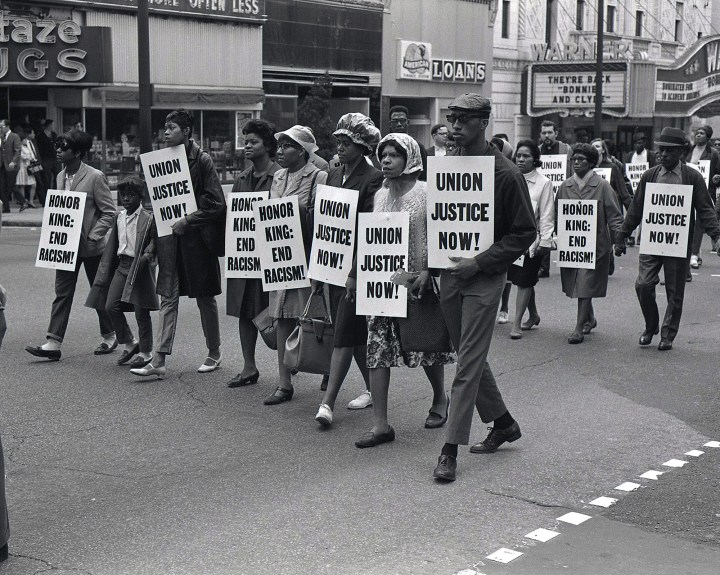A World in Turmoil
Is 2020 a repeat of another dreadful historical period? Watch out

The tremors of politics offer reminders of some other terrible years in the past. Can things be righted or is worse to come?
“Hegel remarks somewhere that all great, world-historical facts and personages occur, as it were, twice. He has forgotten to add: the first time as tragedy, the second as farce.”
― Karl Marx, The Eighteenth Brumaire of Louis Bonaparte
“The only thing we learn from history is that we learn nothing from history.”
— Friedrich Hegel
“Those who don’t know history are doomed to repeat it.”
— Edmund Burke
Back in 1859 and 1860 in America, just prior to the outbreak of the actual Civil War, civil insurrection was already tearing at the fraying social and political fabric of that nation. Radical anti-slavery activist John Brown and his followers had captured the federal armoury at Harper’s Ferry, Virginia in an effort to seize military weapons sufficient to arm a body of men who could end slavery themselves — if the government could not or would not do so. His action only came to naught when a detachment of troops was sent to the scene. And in 1859, there was even violence inside the Capitol Building itself when a pro-slavery representative assaulted an abolitionist senator.
Meanwhile, as part of this pro- versus anti-slavery struggle — settlers (and more than a few “outside agitators”) in the Territory of Kansas had created a near-statewide civil war in what was quickly labelled “Bloody Kansas” over the question of whether Kansas would be admitted to the nation as a full-fledged state that either allowed or prohibited slavery. That vicious Kansas fighting became a practice run for the continent-wide fighting that began the following year, after the election of Abraham Lincoln as president. That fighting ran for four years and led to hundreds of thousands of fatalities until the South was defeated and the scourge of slavery was definitively ended.
A decade earlier, across the Atlantic Ocean, much of Europe was convulsed by insurrections that were led by alliances between new working classes — now moving from rural hinterlands and to the growing cities of the newly industrialising nations — seeking economic reforms. These came together with middle classes now bent on gaining greater political freedom and authority. Much of this new class consciousness had been encouraged by the journalism of social and political critics in the new mass media of the day, people like Karl Marx. The rebellions aimed at doing away with all those outdated, absolutist monarchies and the dead hand of a nobility that had formed the old order, structures that had come back into power after the collapse of the revolutionary changes of the Napoleonic era.
But in 1848, for the most part, the various armies had stayed loyal to their respective governments, although the Austrians eventually called in a Russian army to help make sure that those would-be democrats and rebellious workers toed the line once again. Meanwhile, the Prussian king had refused to accept an all-German crown under a liberal constitution offered by a new Frankfurt parliament, comprised of precisely those kinds of people. And the French replaced their more limited monarchy under King Louis-Phillipe by Louis Napoleon as president, that is until he too had been bitten by imperial dreams, when he eventually overthrew his own elected government.
Some seven decades later, following the conclusion of World War I, in defeated nations like Germany and the newly shrunken nation of Hungary, and even in victorious but disgruntled Italy, political factions fought it out in the streets, most famously in Germany. (In the new Soviet Union, revolutionary armies and the “white” armies fought a devastating civil war for three years, once the czarist and then the Kerensky governments were overthrown.) In Germany, armed groups of far-left Spartakists fought with similarly armed formations of recently demobilised soldiers, the Freikorps, eager to hold off a new leftist regime. Within a decade, however, a major share of Western and Central European political arrangements had descended into authoritarian governments, ultimately with catastrophic results.
Fast forward to 1968. Around the world, in China, Japan, Western Europe, and the US — spiralling out from the numbers of that vast cohort of the global baby boom now coming of age, and with the ongoing Vietnam War and the American civil rights struggle contributing further impetus for western nations — student protests and insurrections, sometimes violent, broke out on campuses and elsewhere. In China, actually beginning two years earlier in 1966, the “Cultural Revolution” was set loose by elements of the government in Mao Zedong’s name. It soon morphed into a nationwide, often uncontrolled spasm that paralysed the entire nation and reshaped its politics and international relations.
In France, student strikes led to the collapse of President Charles de Gaulle’s government; while the German Baader-Meinhof movement, an outgrowth of German student politics and new left politics, evolved into a group that carried out actual criminal actions. Meanwhile, in Japan, student strikes at the prestigious Tokyo University spread into other parts of the capital city, even bringing the national transport grid to a halt with their occupation of one of the country’s biggest combined rail/subway/bus transport mega stations.
In the US, 1968 was a general election year amid vast protests over the Vietnam War, along with violent demonstrations and riots that erupted in the wake of Martin Luther King’s assassination, that devastated the central cores of a number of major American cities. Robert Kennedy was assassinated soon after. State governments began to use increasingly strong efforts to restrain such demonstrations, leading, eventually, in 1970, to the killings of students on several college campuses, the most infamous of them Kent State, Ohio. The net result was that in the wake of this upheaval, Republican presidential candidate Richard Nixon won the election with a “law and order” campaign message that resonated strongly with many unhappy white middle- and working-class voters. (Segregationist candidate, Alabama governor George Wallace, won 5 southern states, the last time a candidate other than Democrat or Republican ever won electoral votes in the US presidential election – Ed)
Increasingly, for many observers, 1968 has a strong contemporary resonance with the events of the present, especially for the US — and beyond. While there is now no unpopular war question to coalesce around, the Covid-19 pandemic and the ensuing economic collapse, along with a new racial advocacy and activism in the wake of several widely reported police killings of black civilians, have seemingly provided fertile ground for new-style “law and order” political candidacies. (Perhaps, too, this is in sync with a drift elsewhere towards “law and order”-style governance and political circumstances of other strong-man, authoritarianism and similar anti-democratic movements and governments in Europe.) And in the US, the current political environment, on the surface at least, now has real echoes with 1968, or even 1919, what with the growing extremist rhetoric from militant groups and some politicians, the public violence, and even the existence of private-style militias stirring the pot or with members engaged in actual killing.
Historian Rick Perlstein recently wrote in The New York Times that “I am a historian best known for a book on how Richard Nixon became president by exploiting white Americans’ racial panic after the fourth straight summer of urban riots. And so a parade of reporters, podcasters and editors came calling: Was the same thing going to happen again? After all, Donald Trump hasn’t been shy about drawing the parallel: during the 2016 campaign, borrowing a famous Nixonism, ‘The Silent Majority Stands With Trump’; these days constantly tweeting ‘LAW AND ORDER!’ whenever the spirit moves him”.
“I repeated a basic observation: When chaos is everywhere, voters tend to reward politicians who promise calm — which is what Nixon seemed credibly to do in 1968. But campaigning for congressional candidates in 1970, Nixon responded to metastasizing disorder under his watch with frenzied rhetoric about ‘thugs and hooligans.’ His even more frenzied vice president, Spiro Agnew, said the thugs and hooligans received ‘fawning approval’ from Democratic elected officials. Meanwhile, Senator Edmund Muskie, Democrat of Maine, gave a soothing election-eve address pointing out how this rhetoric was exacerbating America’s divisions — much in the way Joe Biden points this out now. Then, in the congressional races of that year, voters rewarded Democrats with overwhelming victories. I concluded, ‘When disorder is all around them, voters tend to blame the person in charge — and, sometimes, punish those who exploit the disorder for political gain.’ ”
But Perlstein also argued the two eras have significant divergences. He noted:
“I described the ways the then and the now radically diverge. In the 1960s, the racial backlash followed an unprecedented flurry of civil rights and antipoverty legislation, championed by a liberal president. Because that legislation only seemed to be followed by more anarchy, it was all too easy for millions of white voters to conclude that liberalism was to blame. No such dynamic obtains now. Indeed, on June 10, The New York Times’s Nate Cohn and Kevin Quealy reported that in the previous two weeks, ‘support for Black Lives Matter increased by nearly as much as it had over the previous two years.’ ”
Of course, in the current circumstances, unlike 1968 but perhaps more like those earlier periods of 1859-60 and 1919-20, there are already extremist militia-style bodies geared towards violence and intimidation which are contributing to a national climate. Moreover, in the US, an incumbent president is attempting to make use of these fears and tensions for political profit, offering a kind of authoritarianism-lite prospect filled with the promise to bring order out of the apparent chaos and disorder all around people.
Even if Perlstein could wearily conclude, “But I’m tired of historical parallels. The mind leaps so readily to them, in part because they’re comforting: a defense against the strangeness of both past and present, keeping us from more clearly seeing either. What is called ‘parallel’ is often only human nature. Or American nature — the whole 401 years since 1619. But history is process, not parallels; 2020 cannot be 1968, because 1968 already happened, both conditioning what happened after and making what happened after impossible to understand in the same way. And for each alleged parallel, there may be several counterexamples that do not even rhyme. One that struck me in particular is the night-and-day difference between militant movements saturated with knuckleheaded machismo (‘charged with a sexual atmosphere of the subconscious,’ [historian philosopher Gary] Wills observes) and the adamantly feminist and frequently women-led Black Lives Matter formations, or the white mothers willingly eating tear gas in Portland. Or so it seems to me upon vague impression. I really don’t know. And I would so dearly like to.”
Still, considering these historical retrospectives together with our current circumstances and given the troubling similarities, such observations should make us alert to the reality that the democratic project still remains an experiment. It is susceptible to destabilisation or even destruction. And most important of all, politicians who set such efforts in motion may also reap the whirlwind of their own easy way with the stoking of violence for political gain. DM




















 Become an Insider
Become an Insider
Comments - Please login in order to comment.